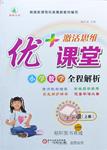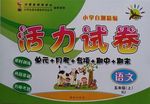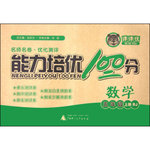
—Can he take charge of the computer company??
—I’m afraid it’s _______ his ability.?
A. beyond B. within?
C. of D. to?
 激活思维优加课堂系列答案
激活思维优加课堂系列答案 活力试卷系列答案
活力试卷系列答案 课课优能力培优100分系列答案
课课优能力培优100分系列答案科目:高中英语 来源: 题型:阅读理解
We hear with our ears, right? Yes, but scientists have known for years that we also hear with our eyes. In a study published in 1976, researchers found that people combined both auditory cues(听力提示) and visual ones,like mouth and face movements, when they heard speech.
A new study that looks at a different set of sensory cues adds to a growing body of evidence that suggests such combination is natural. In a paper, Bryan Gick and Donald Derrick report that people can hear with their skin.
The researchers had volunteers listen to spoken syllables. Meanwhile, they connected the volunteers to a device that would blow a tiny puff (气流) of air onto the skin of their hands or necks. The syllables included “ba” and “pa”, which produce brief puffs from the mouth when spoken, and “da” and “ta,” which do not produce puffs. They found that when listeners heard “da” or “ta” while a puff of air was blown onto their skin, they considered the sounds as “ba” or “pa”.
Dr. Gick said the findings were similar to those from the 1976 study, in which visual cues defeated auditory ones — volunteers listened to one syllable but thought it another because they were watching a video of mouth movements corresponding to the second syllable. In his study,he said,cues from sensory receivers on the skin defeated the ears as well. “Our skin is doing the hearing for us,” he said.
Dr. Gick noted that it would normally be rare that someone actually sensed a puff of air produced by another, although people might occasionally sense their own puffs. “What’s so persuasive about this particular effect,” he added. “is that people are picking up on this information that they don’t know they are using.” That supports the idea that combining different sensory cues is natural.
Dr. Gick said the finding also suggested that other sensory cues might be at work in speech perception(知觉) — that, as he put it, “we are these fantastic perception machines that take in all the information available to us and combine it faultlessly.”
“Da” or “ta” were considered as “ba” or “pa” when __________.
A. they were spoken quickly
B. puffs of air were blown onto the listener’s skin
C. they were pronounced using a special device
D. they were made with face movements
Which of the following statements is TRUE?
A. Humans combine different sensory cues through experience.
B. Dr. Gick’s new study is more important than the one in 1976.
C. People sometimes can sense their own puffs when speaking
D. Only auditory and visual cues are at work in speech perception.
What is the best title of the text?
A. We Can Hear with Our Skin
B. Our Visual Cues Is Doing the Hearing for Us
C. Facial Expressions Are Important
D. We Are Fantastic Machines
查看答案和解析>>
科目:高中英语 来源:2011届江苏省江都中学高三开学适应性练习考试英语卷 题型:阅读理解
We hear with our ears, right? Yes, but scientists have known for years that we also hear with our eyes. In a study published in 1976, researchers found that people combined both auditory cues(听力提示) and visual ones,like mouth and face movements, when they heard speech.
A new study that looks at a different set of sensory cues adds to a growing body of evidence that suggests such combination is natural. In a paper, Bryan Gick and Donald Derrick report that people can hear with their skin.
The researchers had volunteers listen to spoken syllables. Meanwhile, they connected the volunteers to a device that would blow a tiny puff (气流) of air onto the skin of their hands or necks. The syllables included “ba” and “pa”, which produce brief puffs from the mouth when spoken, and “da” and “ta,” which do not produce puffs. They found that when listeners heard “da” or “ta” while a puff of air was blown onto their skin, they considered the sounds as “ba” or “pa”.
Dr. Gick said the findings were similar to those from the 1976 study, in which visual cues defeated auditory ones — volunteers listened to one syllable but thought it another because they were watching a video of mouth movements corresponding to the second syllable. In his study,he said,cues from sens ory receivers on the skin defeate
ory receivers on the skin defeate d the ears as well. “Our skin is doing the hearing for us,” he said.
d the ears as well. “Our skin is doing the hearing for us,” he said.
Dr. Gick noted that it would normally be rare that someone actually sensed a puff of air produced by another, although people might occasionally sense their own puffs. “What’s so persuasive about this particular effect,” he added. “is that people are picking up on this information that they don’t know they are using.” That supports the idea that combining different sensory cues is natural.
Dr. Gick said the finding also suggested that other sensory cues might be at work in speech perception(知觉) — that, as he put it, “we are these fantastic perception machines that take in all the information available to us and combine it faultlessly.”
【小题1】“Da” or “ta” were considered as “ba” or “pa” when __________.
| A.they were spoken quickly |
| B.puffs of air were blown onto the listener’s skin |
| C.they were pronounced using a special device |
| D.they were made with face movements |
| A.Humans combine different sensory cues through experience. |
| B.Dr. Gick’s new study is more important than the one in 1976. |
| C.People sometimes can sense their own puffs when speaking |
| D.Only auditory and visual cues are at work in speech perception. |
| A.We Can Hear with Our Skin |
| B.Our Visual Cues Is Doing the Hearing for Us |
| C.Facial Expressions Are Important |
| D.We Are Fantastic Machines |
查看答案和解析>>
科目:高中英语 来源:2013-2014学年浙江效实中学高一上期期始考英卷(解析版) 题型:阅读理解
A capsule inn is a kind of cheap and small hotel where people just sleep in rectangular containers(容器). After experiencing popularity in Japan for more than 30 years, capsule inns have now entered the Chinese market. This new style is becoming popular with many visitors, but some are less than what they expected. The capsule inn covers an area of more than 300 square meters, with 68 very small bedrooms for guests to rest. Each room is 2.2 meters long and about 1 meter wide.
As small as the capsules are, they provide more than enough daily necessities(必需品) for visitors. They do have plenty of functions. Each includes independent power sockets, clocks, lights, and flat screen televisions. People can also enjoy wireless Internet service. The basic fee(费用) for each capsule is 28 yuan, and guests will be asked to pay an extra 4 yuan every hour. The highest cost could reach 88 yuan per day.
Ta Zan, capsule inn Manager, said, “Capsule inns are similar to Internet cafes. When they first appeared more than 10 years ago, people thought they might not succeed. But now it’s a common thing in our lives.” He believes that more capsule inns will open around the nation very soon. He is sure about the future of his business.
1.How much will you pay if you want to stay in a capsule inn for 12 hours?
A. 88 yuan B. 76 yuan C. 28 yuan D. 4 yuan.
2. What does the underlined word “functions” mean in Chinese?
A. 价格 B. 功能 C. 方法 D. 需求
3.For whom, a capsule inn is a good choice while traveling around?
A. A family who like to cook by themselves.
B. A young student who likes watching TV or surfing on the Internet.
C. An old man who would like to stay in a big house with his wife.
D. A business man who wants to have a meeting with others.
4.Why does the manager compare(比较) his inn to Internet cafes?
A. Because he thinks they are similar in shape.
B. Because he knows Internet cafes were popular 10 years ago.
C. Because he thinks capsule inns are a common thing in our lives.
D. Because he believes both will have good development.
查看答案和解析>>
科目:高中英语 来源:2012-2013学年陕西学大信息技术有限公司经开校区高三上学期三模英语卷(解析版) 题型:阅读理解
The very first capsule hotel to be opened in Shanghai has attracted many budget travelers with its prices, even though it is not fully operational yet.
The hotel consists of 68 "capsules", each 1.1-meters high, 1.1-meters wide and 2.2-meters long. The basic rate is 28 Yuan ($4.22) per person, plus an additional 4 Yuan an hour. The hotel also offers a package of 68 Yuan for 10 hours and 88 Yuan for 24 hours.
All of the capsules are imported from Japan where capsule hotels originated,and each is equipped with independent sockets, clocks, lights, TV and wireless Internet service. The hotel also has a public lavatory(洗手间),shower room, smoking room and shared guest room.
"This is a huge bargain compared with other budget hotels in Shanghai," said Ta Zan, the owner of the hotel. Ta used to stay at capsule hotels in Tokyo during his undergraduate years and worked at a capsule hotel while he was doing his MBA in Japan in 2005, so he knows how they work and how to make guests feel comfortable.
He based the hotel on capsule hotels in Japan but he has made some special changes based on Chinese guests' habits. "In Japan capsule hotels are usually equipped with bathtubs, but in China people are more willing to take a shower, so we have the shower room," he said. He has also separated the capsules into three snoring (打鼾的) zones so that guests who often snore won't disturb others. Like most of capsule hotels in Japan, the one in Shanghai is for men only.
But the idea of staying in such a compact space is not appealing to everyone. "I feel the idea is like putting a person in a coffin (棺材), and the price is also not that appealing. A bed at a youth hostel in Shanghai costs about 60 Yuan per night," said Wang Lei, a student from Beijing.
1.The first capsule hotels in the world appeared in .
A. Shanghai B. Japan C. Beijing D. America
2.If you stay in the capsule hotel in Shanghai for 8 hours, you will have to pay yuan.
A. 28 B. 60 C.68 D.88
3.What does the underlined word "compact" mean?
A. Dear B. Cheap. C. Close. D. Clean.
4.The capsule hotel in Shanghai differs from those in Japan in that .
A. it serves men as well as women
B. its capsule is much larger
C. it has a shower room
D. it has no snoring zones
5.We can know from the passage that .
A. everybody considers the capsule hotel a nice place to stay
B. all the capsules of the hotel were made in China
C. each capsule of the hotel has a private lavatory
D. no guest has ever stayed in the capsule hotel in Shanghai
查看答案和解析>>
科目:高中英语 来源:2010-2011学年江苏省高三开学适应性练习考试英语卷 题型:阅读理解
We hear with our ears, right? Yes, but scientists have known for years that we also hear with our eyes. In a study published in 1976, researchers found that people combined both auditory cues(听力提示) and visual ones,like mouth and face movements, when they heard speech.
A new study that looks at a different set of sensory cues adds to a growing body of evidence that suggests such combination is natural. In a paper, Bryan Gick and Donald Derrick report that people can hear with their skin.
The researchers had volunteers listen to spoken syllables. Meanwhile, they connected the volunteers to a device that would blow a tiny puff (气流) of air onto the skin of their hands or necks. The syllables included “ba” and “pa”, which produce brief puffs from the mouth when spoken, and “da” and “ta,” which do not produce puffs. They found that when listeners heard “da” or “ta” while a puff of air was blown onto their skin, they considered the sounds as “ba” or “pa”.
Dr. Gick said the findings were similar to those from the 1976 study, in which visual cues defeated auditory ones — volunteers listened to one syllable but thought it another because they were watching a video of mouth movements corresponding to the second syllable. In his study,he said,cues from sensory receivers on the skin defeated the ears as well. “Our skin is doing the hearing for us,” he said.
Dr. Gick noted that it would normally be rare that someone actually sensed a puff of air produced by another, although people might occasionally sense their own puffs. “What’s so persuasive about this particular effect,” he added. “is that people are picking up on this information that they don’t know they are using.” That supports the idea that combining different sensory cues is natural.
Dr. Gick said the finding also suggested that other sensory cues might be at work in speech perception(知觉) — that, as he put it, “we are these fantastic perception machines that take in all the information available to us and combine it faultlessly.”
1.“Da” or “ta” were considered as “ba” or “pa” when __________.
A. they were spoken quickly
B. puffs of air were blown onto the listener’s skin
C. they were pronounced using a special device
D. they were made with face movements
2.Which of the following statements is TRUE?
A. Humans combine different sensory cues through experience.
B. Dr. Gick’s new study is more important than the one in 1976.
C. People sometimes can sense their own puffs when speaking
D. Only auditory and visual cues are at work in speech perception.
3.What is the best title of the text?
A. We Can Hear with Our Skin
B. Our Visual Cues Is Doing the Hearing for Us
C. Facial Expressions Are Important
D. We Are Fantastic Machines
查看答案和解析>>
湖北省互联网违法和不良信息举报平台 | 网上有害信息举报专区 | 电信诈骗举报专区 | 涉历史虚无主义有害信息举报专区 | 涉企侵权举报专区
违法和不良信息举报电话:027-86699610 举报邮箱:58377363@163.com